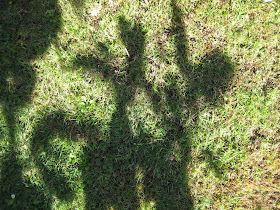 Shadow tracing is a project that students from about 2nd or 3rd grade and up will love doing. It fits right in with discussions about composition, color theory and positive/negative shapes. In the interest of full disclosure, one of the reasons students love it so much is that they have to go outside to
Shadow tracing is a project that students from about 2nd or 3rd grade and up will love doing. It fits right in with discussions about composition, color theory and positive/negative shapes. In the interest of full disclosure, one of the reasons students love it so much is that they have to go outside to  do it! I guess we don't get out as often as we should in Art class, so can you blame them??
do it! I guess we don't get out as often as we should in Art class, so can you blame them??Shadow tracing is low stress for students and has minimal prep for teachers. Students can usually finish one of these paintings in a single class period, or you may want to let your students do a few tracings the first day and paint them the next. Here's how you do it....
On a bright, sunny day, look outside for areas with strong shadow patterns, on the ground or even against buildings. All kinds of things make interesting shadows....
 fences, railings, chairs, trees and all kinds of plants, just to name a few. Once you start looking for shadows, you'll be amazed at how you'll be noticing them everywhere! (This is a great exercise for learning to see like an artist!)
fences, railings, chairs, trees and all kinds of plants, just to name a few. Once you start looking for shadows, you'll be amazed at how you'll be noticing them everywhere! (This is a great exercise for learning to see like an artist!)Lay a piece of white construction paper (I like 12x18, but you can work smaller or larger if you want) over the shadow and turn it until you have a composition you're satisfied with. Then, trace the shadow with a pencil. (You'll need to work quickly, as shadows change with the movement of the sun!) Your tracing will show positive and negative shapes. (The shadow is the positive shape and the space around it is the negative shape.)

Once back inside, you can instruct your students how you'd like them to paint their tracings. Some possible ideas are warm and cool colors, complimentary colors, analogous colors (like the example here), tints and shades of a color.... the list could go on and on. You get the idea! The result will be a classroom full of very unique abstract paintings.... no two will be alike!
So cool!!
ReplyDeleteAll of the students can call their finished piece "The Shadow".
ReplyDeleteGreat idea!! RT